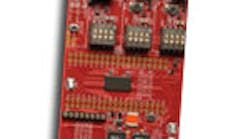802.11n Connect-io-n modules
Redpine 802.11n module
Wi-Fi normally isn’t used as a wireless I/O interface in embedded applications, including cell phones. It generally uses too much power and has to communicate through an access point. Now, Redpine Signals offers ultra-low-power chips and modules based on the IEEE 802.11n standard in its single stream (no MIMO) form, making it easy to include Wi-Fi in almost any product. And using the Wi-Fi Alliance’s Wi-Fi Direct standard, peer-to-peer connections enable devices to talk to one another one-to-one without an access point.
Redpine recently announced its new 802.11n solution in cooperation with Renesas Electronics America Inc. The Redpine products make it easy for system engineers to add single-stream 802.11n Wi-Fi capability to embedded systems that use the Renesas R8C, RX, and SuperH (SH) microcontrollers (MCUs).
These solutions are based on Redpine’s Connect-io-n and n-Link series of modules (Fig. 1), which make it easy to design new systems and upgrade existing products to provide reliable wireless data communications while meeting various power and throughput requirements. Key applications include home appliances; medical equipment such as remote patient monitors; home gateways; and security systems, thermostats, HVAC equipment, home automation systems, and lighting control systems for residential buildings.
The Connect-io-n and n-Link modules implement single-stream 802.11n connectivity in a smaller space, at less cost and using less power than legacy 802.11b and 802.11g modules. System developers don’t have to have a detailed knowledge of wireless or Wi-Fi technology to apply them, removing major barriers to the widespread adoption of the 802.11n wireless communication standard in embedded system applications. If you need Internet connectivity in an embedded device, this is a good way to get it.
Renesas customers can readily integrate the self-contained Connect-io-n 802.11n modules into any existing Renesas Electronics MCU-based system, including designs built with devices in the R8C, RX, and SH families. The Redpine module products offer serial peripheral interfaces (SPIs) and UART interfaces and provide wireless connectivity up to 10 Mbits/s on the SPI or up to 4 Mbits/s on the UART interface.
Available with an option for TCP/IP and Web applications embedded within the Wi-Fi module, the Connect-io-n modules enable extremely small MCU driver footprints: less than 9 kbytes for the SPI and less than 2 kbytes for the UART interface. As a result, existing R8C-, RX-, and SH-based designs can be enhanced with future-proof Wi-Fi 802.11n functionality by adding as little as 2 kbytes of new software and minimal hardware changes in the MCU hardware. The modules are fully FCC certified.
The higher-performance n-Link 802.11n modules have SDIO/SPI host interfaces and are ideal for applications that must deliver greater throughput (up to 35 Mbits/s) or require stringent quality of service (WMM-PS for voice/video, etc.). Redpine provides the required SDIO driver, HAL, Wi-Fi management, and operating-system (OS) abstraction functions for the n-Link modules. The higher data rates offered by 802.11n enable shorter packet durations, resulting in a much longer battery life than competing 802.11b or 802.11b/g solutions.
The Connect-io-n and n-Link modules (Fig. 2) are based on Redpine’s mature Lite-Fi chipset, the industry’s first Wi-Fi certified 802.11n single-stream device. These modules have best-in-class transmit power of 18 dBm, as well as receiver sensitivity down to –98 dBm, so they enable wireless designs with excellent range. They also offer less than 0.01-mW shutdown power, less than 3-mW associated mode power, and active operational power as low as 30 mW (100-kbit/s SPI).
As a result, the modules make it possible to implement ultra-low-power wireless battery-operated applications with more than 10 years of battery life with burst updates at rates faster than 1 kbyte at 15-minute intervals. Further, starting at a small size of 11 by 13 mm, they offer system integrators modular certification for FCC/IC/CE to simplify product development. The variants that support dual-band 2.4/5.0-GHz band operation serve applications that demand better reliability and quality of service in crowded wireless environments.
Redpine and Renesas have collaborated to provide a Wi-Fi an evaluation kit based on the Renesas R8C series of low-power MCUs. This kit includes the Renesas Starter Kit for the R8C/25 MCU, an 802.11n companion board based on the Redpine Connect-io-n module, an E8a hardware debugger, the HEW integrated development environment (IDE), an evaluation compiler, and all necessary software examples and documentation. It’s pre-loaded with a demonstration application and is accompanied by a PC-based GUI application. With these, system designers can establish connections to an existing wireless infrastructure and begin interaction with the kit from a PC wirelessly in less than 15 minutes.
Customers can purchase the R8C-based Wi-Fi kit (RS2201R8C25) from Redpine’s online store. Available for $299, the kit includes the R8C RSK and the RS9110-N-11-22-01 Connect-io-n Companion Card.


